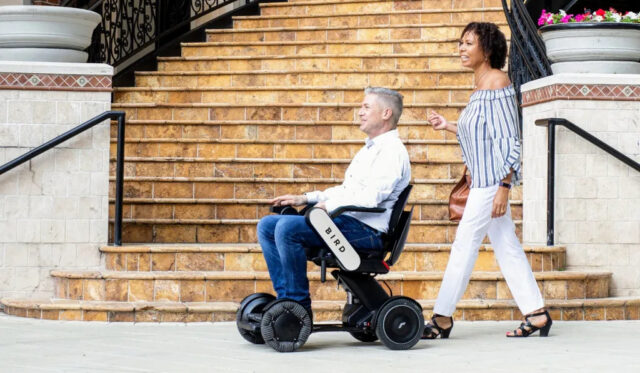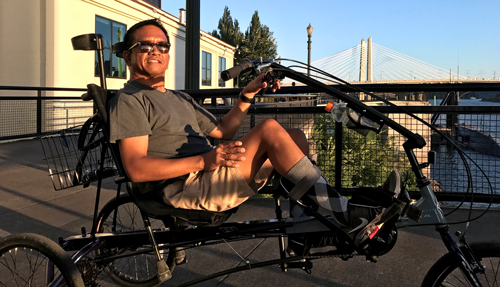NYC Wants to Get Adaptive Mobility Right
by Kiran Herbert, Communications Manager
May 4, 2022
Through partnerships, programming, and new technology, the city hopes to make shared micromobility available to everyone.

Bird riders in select markets now have access to accessible vehicles, including the WHILL Model Ci2. (Photos courtesy of Bird).
In March 2022, the shared micromobility company Bird launched a new adaptive program that provides motorized attachments for wheelchair users in New York City. While the pilot is only available to those living in select parts of the Bronx, the service is completely free to use and compatible with most wheelchairs that have seat widths between 14 and 22 inches. The attachment, which includes a handlebar, front wheel, and an electric battery-powered motor, secures to the front of the wheelchair and, similar to an e-scooter, operates using a throttle.
Interested and qualified residents can opt-in to the program, at which point Bird drops off the model and installs the device before overseeing a test ride. The initiative is part of a larger e-scooter pilot program launched by New York City’s Department of Transportation (NYCDOT) in spring 2021. That pilot made about 3,000 e-scooters — from Bird, Lime, and Veo — available to residents of the East Bronx. This summer, it’s set to double its scooter numbers and expand to even more neighborhoods in the Bronx. From the get-go, NYCDOT required all three scooter providers to also provide wheelchair-accessible scooters — the new wheelchair attachment is on top of Bird’s other accessibility offerings.
In July 2021, Bird announced a partnership with Scootaround, a mobility company that’s been renting accessible devices across the U.S. and Canada for some 20 years. In 2019, WHILL, which makes power wheelchairs, merged with Scootaround and the company’s devices — including the WHILL Model Ci2 pictured above — are what’s now being offered through the Bird app in the Bronx, as well as in Yonkers, San Francisco, San Diego, San Jose, and Seattle. In these markets, people with mobility needs can have a device delivered to their door and rent it for up to two weeks, all at the highly subsidized rate of $5/day (typical rates run about 10 times as much).
Although the partnership with Scootaround first rolled out in the Bronx, it’s part of a larger plan to help fill a void in the market for adaptive riders. For cities, it also makes contracting with Bird all the more appealing. Jonathan Jennings, VP of marketing at Scootaround, is hopeful that the partnership will continue to expand across the country, helping break down a collective skepticism around the normalized use of mobility devices.
“We want to overcome the hesitance that people have to seek out these devices,” says Jennings, noting that many people opt not to travel at all rather than slow others down or seek out help. “Once you get people over that hump, it’s life-changing for them.”
While adaptive devices can help improve the lives of someone with a spinal injury, helping them to move faster, accomplish more, and travel with groceries, they’re just as beneficial to a 20-year-old with a broken foot or an older person that might not feel comfortable riding a bike or a scooter. Navigating city streets on a seated scooter can be a game-changer, allowing people to still move freely and efficiently outside of a car.
“It’s just a mobility device that’s the same as a bicycle — it’s just about finding the right mobility device for you,” says Jennings. “If we can bring that [choice] to the street corner one day, that would be the end goal. It would be an amazing thing to see.”
Jennings believes that taking these sorts of adaptive devices outside of the medical realm and marketing them through a shared micromobility company like Bird both reduces stigma and increases adoption. In New York, NYCDOT worked hard with all the chosen mobility companies to ensure accessibility was truly baked into its pilot from the start. For Bird, the requirement was a welcome opportunity.
“We want to make sure we’re able to serve as many people as possible,” says Sam Cooper, senior director of government partnerships at Bird. “That means adding options for people with disabilities to get where they need to go in an affordable and easy manner.”
Cooper says that Bird is open to scaling to as many markets as possible and thus far hasn’t run into objections from partners in any cities. He believes that disability advocates need to be in on the conversation from the beginning, however, to ensure that people both know about the programming and that they have a say in its execution.
“You need to have those hyper-local connections in each market,” says Cooper, adding that municipalities have an important role to play in facilitating those relationships and holding companies accountable. “Cities need to make serving people with disabilities a priority.”
All operators in the New York City pilot program are required to meet regularly with the Mayor’s Office for People with Disabilities, as well as a group of advocates from organizations like Disabled in Action and Downstate New York ADAPT, who represent the city’s disability community. This setup has allowed the city to better gauge demand for these sorts of offerings while providing Bird, Lime, and Veo with a forum to get feedback on their programming and remain responsive. Plus, it helps ensure they’re operating efficiently in the public right-of-way.
“It was very important for the disability community to be part of the conversation from the beginning,” says Jose Hernandez, president of United Spinal Association’s New York City Chapter and a member of the advisory committee. “We’re left out a lot of times and when problems arise, it’s like, they should have come to us in the beginning and we could have gotten it right from the start.”
Creating a direct line between the disabled community and shared micromobility operators has helped identify and rectify issues that exist in any market. Things like scooters being left on sidewalks and becoming obstacles, which is especially difficult to navigate as a wheelchair user or blind person, or the need for a sound to be added to scooters for awareness, which is important to the blind and hard of hearing. Outside of meetings, Hernandez says that he maintains contact with Cooper and appreciates having a direct line to offer feedback.
“The obstruction, that’s something that can be solved,” says Hernandez, adding that it’s important to iron out any issues during the pilot before launching across New York City. “They’re doing this the right way by releasing the program in small steps, figuring out what works and what doesn’t, and solving those issues before expanding.”
Hernandez also appreciates that it’s not just one company doing the work, noting that between Bird, Lime, and Veo, there’s an array of offerings that suit just about everyone’s needs. Veo also offers an electric adaptive wheelchair device, in addition to its flagship seated scooter, and Lime has its Lime Able program, which provides free 24-hour use of home-delivered adaptive vehicles to those that can’t use the company’s e-bikes or e-scooters. That program kicked off in Oakland, California, before expanding to New York City and eight other urban areas across the country.
Importantly, all of the e-scooter companies were required to provide discounted fares to New Yorkers receiving federal assistance. This is especially important for the disabled community — people with disabilities live in poverty at more than twice the rate of people without disabilities. In an effort to further reduce barriers, the NYCDOT also worked with the partner companies to allow cash payments and text-message booking to reserve and use e-scooters. What’s more, all vehicles available in the pilot can be ridden on both the sidewalk and on the roadbed, including bike lanes, helping to avoid the potential of racialized interactions with law enforcement.
The most important thing, however, might just be the joy accessible mobility can offer New Yorkers.
“There are a lot of individuals with disabilities who go without having ridden a bike or being able to use a scooter because of their disability and this gives them the ability to enjoy a beautiful day in the spring, summer, or fall, maybe cruising along a bike path with either their kids or their loved ones,” says Hernandez. “It’s an additional option to get around and enjoy the city and I think that’s a great thing. It’s something we should all look forward to.”
The Better Bike Share Partnership is funded by The JPB Foundation as a collaboration between the City of Philadelphia, the National Association of City Transportation Officials (NACTO) and the PeopleForBikes Foundation to build equitable and replicable bike share systems. Follow us on Facebook, Twitter and Instagram or sign up for our weekly newsletter. Got a question or a story idea? Email kiran@peopleforbikes.org.



